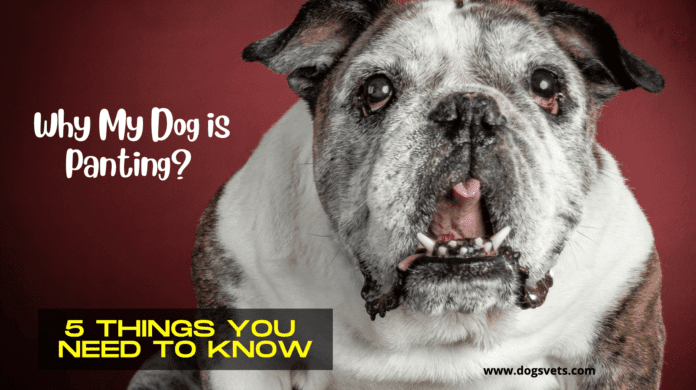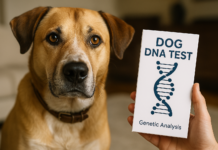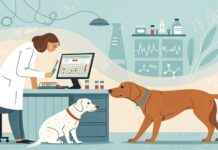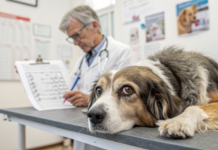Last Updated on July 21, 2023 by Dogs Vets
Why My Dog is Panting
Your dog has started panting heavily when lying down. This is not after daily walks, thunderstorms, loud noises, or even firecrackers. His breathing has also become labored while he is sleeping. So, what could be the cause?
What are the symptoms that might indicate a serious health condition? Read on to learn how to determine the root cause of your dog’s labored breathing. Here are a few possible explanations.
Symptoms of laryngeal paralysis
A veterinary diagnosis of laryngeal paresthesia is crucial in helping you determine if your dog has the condition. It may start out mild and grow worse over time.
Dogs with laryngeal paralysis are more likely to become overheated during exercise and in warmer climates because they cannot cool themselves through panting. As a result, they may even suffer heatstroke.
Large breed dogs and giant breed dogs are most commonly affected by laryngeal paralysis.
The typical patient is an older, large breed dog. Labradors are the poster dog for this condition, but Golden retrievers, Setters, and Boxers may also develop laryngeal paralysis.
In most cases, the disease progresses slowly. It usually starts with noisy breathing and becomes worse during normal activity.
A veterinarian will listen carefully to your dog’s breathing and check for any signs of laryngeal paralysis.
If you notice signs of laryngeal disease in your dog, it’s important to seek medical attention immediately.
Your veterinarian may suggest a sedative or other medication to relax the muscles in the larynx.
If your dog is unable to breathe deeply, a temporary tracheostomy tube may be necessary.
Although the vast majority of cases of laryngeal paralysis are idiopathic, some diseases and disorders can affect the nerves that control the larynx.
A veterinarian may recommend surgery to correct the problem. Although this treatment option is not perfect, it is extremely effective in some cases.
A board-certified veterinary surgeon will perform this operation. This procedure involves an incision in the neck and tying back one cartilage, preventing it from blocking airflow.
Sometimes both cartilages are affected. If a dog’s larynx is completely paralyzed, the surgery may be needed.
A veterinarian’s assessment of the dog’s condition will include a thorough physical examination and blood tests to rule out any other diseases.
A radiograph may also be necessary to rule out the presence of a tumor or other potential cause of laryngeal paralysis. Once you have confirmed that the condition is laryngeal, your vet will recommend the appropriate treatment.
Symptoms of arthritis
Some common symptoms of arthritis in dogs include reduced energy, stiffness, and lameness. Your dog may not stand up on its own or yell out in pain. You may also notice your dog sitting with the painful area extended.
Your dog may seem weak when walking and may slouch more than usual. Osteoarthritis causes gradual degradation of the joint’s health, affecting the articular cartilage, synovial membrane, and subchondral bone.
Treatment for arthritis in dogs involves several options for pain relief and management. The first line of therapy involves reducing inflammation and discomfort.
Certain medications, such as corticosteroids, can reduce inflammation and reduce pain.
However, corticosteroids can cause further damage to joints. In addition to steroids, veterinarians may prescribe safe NSAIDs, also known as “dog NSAIDs,” to treat joint pain.
Advanced cases of arthritis may require surgery, pain relievers, or a combination of these treatments.
There are many different types of arthritis in dogs, and symptoms vary widely from one individual to another.
A veterinarian can properly diagnose arthritis in dogs by doing a thorough examination and talking with you about your pet’s symptoms and medical history.
X-rays of your dog’s joints may be required to rule out other causes of arthritis. Once the cause is diagnosed, the veterinarian can develop a personalized treatment plan for your dog’s arthritis.
Dogs with arthritis may exhibit signs of joint pain, including slowness and stiffness. The condition is most common in older dogs, large breeds, and breeds with genetically linked disorders.
Breeds that tend to develop arthritis include Chihuahuas, Bulldogs, and Yorkshire Terriers. Labrador Retrievers and Mastiffs are also prone to hip dysplasia.
Treatment for arthritis in dogs may help your dog stay comfortable and pain-free.
While arthritis is common in older dogs, it can also affect puppies and older animals.
There are many effective therapies available for dogs with arthritis, including physical therapy.
Some owners have even found success with holistic therapies, such as acupressure or targeted pulsed electromagnetic field therapy.
The benefits of these therapies are well worth pursuing. You may even find a cure for your dog’s arthritis! The sooner you recognize the symptoms of arthritis, the better.
Fact Check
We hope you enjoyed this article… What are your thoughts?
Рleаse let us knоw yоur thоughts in the соmments seсtiоn. Feel free to share with us in the comments section below.

















